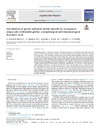Identificador persistente para citar o vincular este elemento:
https://accedacris.ulpgc.es/jspui/handle/10553/75153
| Campo DC | Valor | idioma |
|---|---|---|
| dc.contributor.author | Fernández Montero, Álvaro | - |
| dc.contributor.author | Montero, D. | - |
| dc.contributor.author | Izquierdo, M. S. | - |
| dc.contributor.author | Acosta, F. | - |
| dc.contributor.author | Caballero, M. J. | - |
| dc.contributor.author | Torrecillas, S. | - |
| dc.date.accessioned | 2020-11-03T09:57:46Z | - |
| dc.date.available | 2020-11-03T09:57:46Z | - |
| dc.date.issued | 2020 | - |
| dc.identifier.issn | 2352-5134 | - |
| dc.identifier.other | Scopus | - |
| dc.identifier.uri | https://accedacris.ulpgc.es/handle/10553/75153 | - |
| dc.description.abstract | Neobenedenia girellae is considered an epizootic infection for intensively cultured fish species. Particularly, for greater amberjack (Seriola dumerili) N. girellae causes high mortality rates and supposes a bottleneck during its on-growing period. Thus, the objective of this work was to describe the skin morphological alterations caused by a N. girellae infection on greater amberjack. Greater amberjack juveniles were sampled pre and post experimental infection with N. girellae obtaining cranial and dorsal skin samples. Samples were processed for morphological and ultrastructural studies and revealed clear differences in the structure of both regions, confirming the cranial region as the most susceptible region to be parasitized due to an absence of scales and lower goblet cells density. N. girellae adhesion disrupted the structure of epidermal epithelial cells by overpressure. Stratum spongiosum surface-epithelial cells located near the parasite presented a clear cell degradation process, associated in some cases with cellular detachment. N. girellae infection induced epidermal hydropic degeneration and, in some cases, focal spongiosis. Tissue ulcerative lesions caused by the parasite's attachment structures were characterized by a specific mobilization of leucocytes to the fixation areas. Thus, N.girellae induces important alterations in greater amberjack epidermis independently of the skin region that explain the appearance of secondary infections and associated mortalities. | - |
| dc.language | eng | - |
| dc.relation.ispartof | Aquaculture Reports | - |
| dc.source | Aquaculture Reports [EISSN 2352-5134], v. 18, 100505 (Noviembre 2020) | - |
| dc.subject | 251092 Acuicultura marina | - |
| dc.subject.other | Aquaculture | - |
| dc.subject.other | Ectoparasite | - |
| dc.subject.other | Epithelium | - |
| dc.subject.other | Fish | - |
| dc.subject.other | Histopathology | - |
| dc.title | Skin infection of greater amberjack (Seriola dumerili) by monogenean ectoparasite neobenedenia girellae: A morphological and histopathological descriptive study | - |
| dc.type | info:eu-repo/semantics/Article | - |
| dc.type | Article | - |
| dc.identifier.doi | 10.1016/j.aqrep.2020.100505 | - |
| dc.identifier.scopus | 85093699600 | - |
| dc.contributor.authorscopusid | 57200550839 | - |
| dc.contributor.authorscopusid | 35605929400 | - |
| dc.contributor.authorscopusid | 7103111891 | - |
| dc.contributor.authorscopusid | 56269311600 | - |
| dc.contributor.authorscopusid | 7102935199 | - |
| dc.contributor.authorscopusid | 21733894700 | - |
| dc.identifier.eissn | 2352-5134 | - |
| dc.relation.volume | 18 | - |
| dc.investigacion | Ciencias | - |
| dc.type2 | Artículo | - |
| dc.description.numberofpages | 10 | - |
| dc.utils.revision | Sí | - |
| dc.date.coverdate | Noviembre 2020 | - |
| dc.identifier.ulpgc | Sí | - |
| dc.description.sjr | 0,74 | - |
| dc.description.jcr | 3,216 | - |
| dc.description.sjrq | Q1 | - |
| dc.description.jcrq | Q1 | - |
| dc.description.scie | SCIE | - |
| item.fulltext | Con texto completo | - |
| item.grantfulltext | open | - |
| crisitem.author.dept | GIR Grupo de Investigación en Acuicultura | - |
| crisitem.author.dept | IU de Investigación en Acuicultura Sostenible y Ec | - |
| crisitem.author.dept | Departamento de Biología | - |
| crisitem.author.dept | GIR Grupo de Investigación en Acuicultura | - |
| crisitem.author.dept | IU de Investigación en Acuicultura Sostenible y Ec | - |
| crisitem.author.dept | Departamento de Biología | - |
| crisitem.author.dept | GIR Grupo de Investigación en Acuicultura | - |
| crisitem.author.dept | IU de Investigación en Acuicultura Sostenible y Ec | - |
| crisitem.author.dept | Departamento de Patología Animal, Producción Animal, Bromatología y Tecnología de Los Alimentos | - |
| crisitem.author.dept | GIR IUSA-ONEHEALTH 3: Histología y Patología Veterinaria y Forense (Terrestre y Marina) | - |
| crisitem.author.dept | IU de Sanidad Animal y Seguridad Alimentaria | - |
| crisitem.author.dept | Departamento de Morfología | - |
| crisitem.author.dept | GIR Grupo de Investigación en Acuicultura | - |
| crisitem.author.dept | IU de Investigación en Acuicultura Sostenible y Ec | - |
| crisitem.author.orcid | 0000-0002-4358-2157 | - |
| crisitem.author.orcid | 0000-0003-4297-210X | - |
| crisitem.author.orcid | 0000-0002-1098-7529 | - |
| crisitem.author.orcid | 0000-0002-2575-0997 | - |
| crisitem.author.parentorg | IU de Investigación en Acuicultura Sostenible y Ec | - |
| crisitem.author.parentorg | IU de Investigación en Acuicultura Sostenible y Ec | - |
| crisitem.author.parentorg | IU de Investigación en Acuicultura Sostenible y Ec | - |
| crisitem.author.parentorg | IU de Sanidad Animal y Seguridad Alimentaria | - |
| crisitem.author.parentorg | IU de Investigación en Acuicultura Sostenible y Ec | - |
| crisitem.author.fullName | Fernández Montero, Álvaro | - |
| crisitem.author.fullName | Montero Vítores, Daniel | - |
| crisitem.author.fullName | Izquierdo López, María Soledad | - |
| crisitem.author.fullName | Acosta Arbelo, Félix Antonio | - |
| crisitem.author.fullName | Caballero Cansino, María José | - |
| crisitem.author.fullName | Torrecillas Burriel, Silvia | - |
| Colección: | Artículos | |
Citas SCOPUSTM
8
actualizado el 08-jun-2025
Citas de WEB OF SCIENCETM
Citations
7
actualizado el 08-jun-2025
Visitas
256
actualizado el 31-may-2025
Descargas
175
actualizado el 31-may-2025
Google ScholarTM
Verifica
Altmetric
Comparte
Exporta metadatos
Los elementos en ULPGC accedaCRIS están protegidos por derechos de autor con todos los derechos reservados, a menos que se indique lo contrario.
